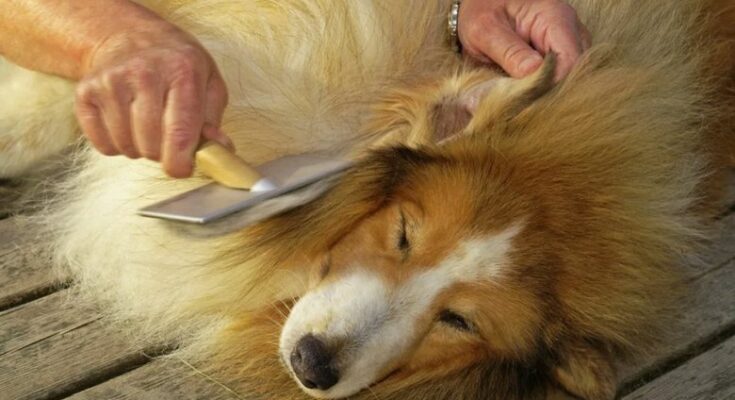Regularly brushing your dog’s coat is important primarily for their health. Just imagine what kinds of parasites could settle under dirty mats and tangles. Plus, these clumps of fur pull on the hair as the dog moves, causing pain when walking or running. It’s especially concerning when the fur becomes so matted that it turns into a solid shell. Dead hair must be removed by brushing—this reduces the risk of skin infections, allergies, and it’s simply more hygienic. In addition, it improves blood circulation, coat quality, and skin condition.
So, how do you brush a dog without harming the skin or causing stress?
Preparing for Brushing
First of all, you’ll need to be patient. Even if your dog has a lot of mats, shaving isn’t always the right solution. You may need to spend a couple of hours!
Choosing the right place for the procedure is also important, as fur will fly everywhere during brushing. Avoid places like the sofa, bed, or carpet—you’ll just end up having to clean them afterward. It’s better to find a spot where the fur can be easily gathered and cleaned up.
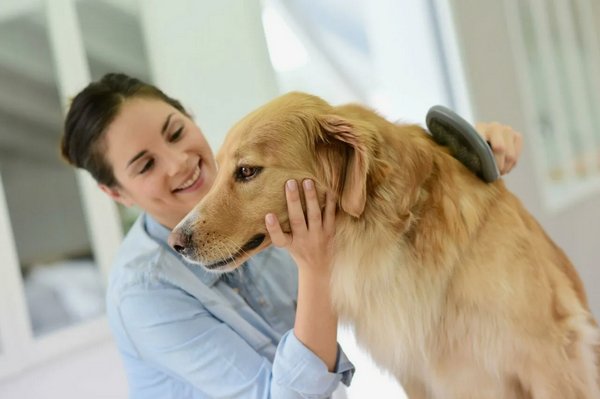
You probably don’t have a professional grooming table, but a raised surface like a low table, nightstand, or wide stool will work. In the worst case, you can lay a piece of cloth under the dog that’s easy to shake out afterwards. Brushing your pet while sitting on the floor is quite uncomfortable. And if your stand is too low, your back will definitely suffer.
Also, make sure you wear clothes you don’t mind getting dirty. In more neglected cases, it’s worth wearing a medical mask to prevent fine hairs from getting into your airways. Be careful not to get fur in your eyes either.
Brushing Tools
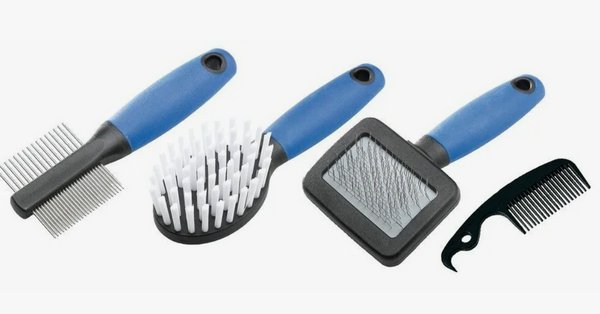
Choose brushing tools that are comfortable and suitable for your dog’s coat type. These may include slicker brushes, bristle brushes, undercoat rakes, deshedders, various combs (including ones with sharp teeth), trimmers, and stripping tools.
These are all professional tools, each with a specific purpose—and using them correctly requires some skill.
So don’t hesitate to choose simpler tools from the pet store—ones that you can easily use at home. These include basic combs, brushes, and slickers. If you work gently, you can manage even the toughest mats.
And one more piece of advice: stay calm—always calm. Brushing may be uncomfortable for an unprepared dog. She will try to squirm out of your hands, and might even whine, squeal, or howl—even if it doesn’t really hurt. She just doesn’t want to sit still, especially when something strange is happening to her.
So don’t yell at your dog, and definitely don’t slap her sides. Stay firm but gentle.
In fact, if you’re careful, your dog will soon understand that brushing can be pleasant. When else does the owner give such a lovely scratch on the back, neck, and belly? The brushing experience should leave a positive memory, so reward her every now and then with a tasty treat.
Assessing Your Dog’s Coat Type
First, you need to determine your dog’s coat type—short-haired, long-haired, whether the undercoat is dense or absent altogether, as is the case with Yorkshire Terriers.
Short Hair: Features
Short-haired dogs require a special approach to grooming, despite the process seeming simpler. Their fur doesn’t tangle or mat easily, and their skin is easily accessible for inspection. However, these dogs shed more frequently because their coat renews itself faster. Shedding is especially noticeable in spring and autumn when fine hairs fall out actively and can spread all over the house.
Additionally, short hair gets dirty faster and may emit an unpleasant odor. This is because short-haired breeds produce about a third more skin oil. Since the hairs lie close to the skin, water may just roll off during bathing, and dirt may be harder to wash away. Therefore, hygiene procedures require more attention.
Long Hair: Features
Long hair can be soft and silky or coarse. Breeds like Maltese and Poodles have curly hair, which requires special care. Almost all long-haired breeds have a dense undercoat.
Long hair tends to mat easily, making it much harder to brush. The undercoat can be so thick that it’s very difficult to comb through. During shedding season in spring and autumn, the undercoat becomes the biggest challenge.
How to Brush Your Dog Properly
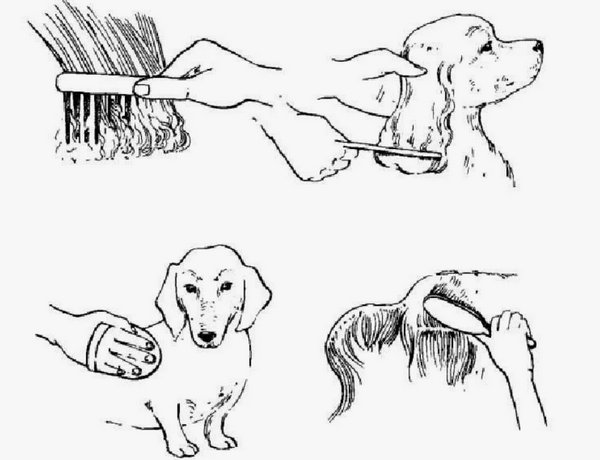
The main rule is to always brush the dog in the direction of hair growth. It’s best to start with the front paws, then move to the face, ears, neck, chest, and so on. What should you brush first—the belly or the back? Whichever is more comfortable for you and your dog. From personal experience, it’s better to start with the back, then move to the sides, and then the belly. After that, brush the hind legs, the area under the tail, and the tail itself.
Brushing Short Hair
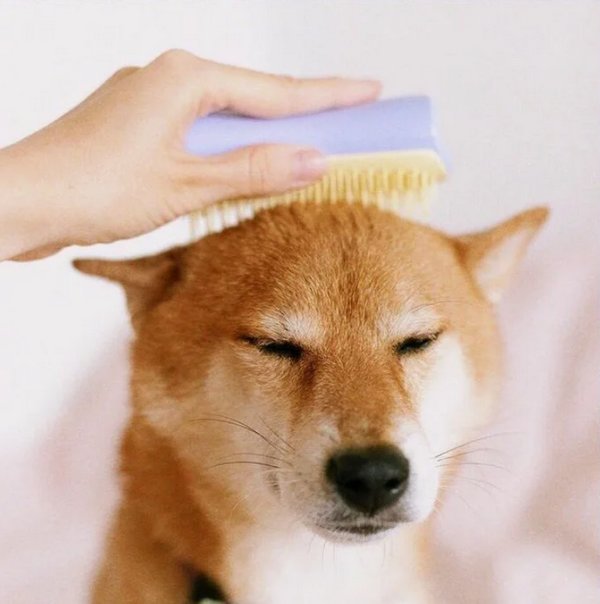
Short hair usually doesn’t pose much of a problem when brushing. Avoid using combs with long teeth. Instead, a variety of brushes work well, including those with soft bristles or small metal pins.
If the coat is very short, a special grooming glove is ideal for brushing the undercoat. A big advantage is that a lot of hair sticks to the glove, which is easy to remove and discard. Slicker brushes also work, but they tend to scatter the fine hairs more. Gloves offer a gentler touch and help collect more of the fine hair.
Keep in mind that short-haired dogs feel the brush bristles more intensely on their skin. So, avoid brushing one spot for too long or applying too much pressure. This can be unpleasant for your dog, causing them to get fussy—and they may resist brushing altogether next time.
Long Hair
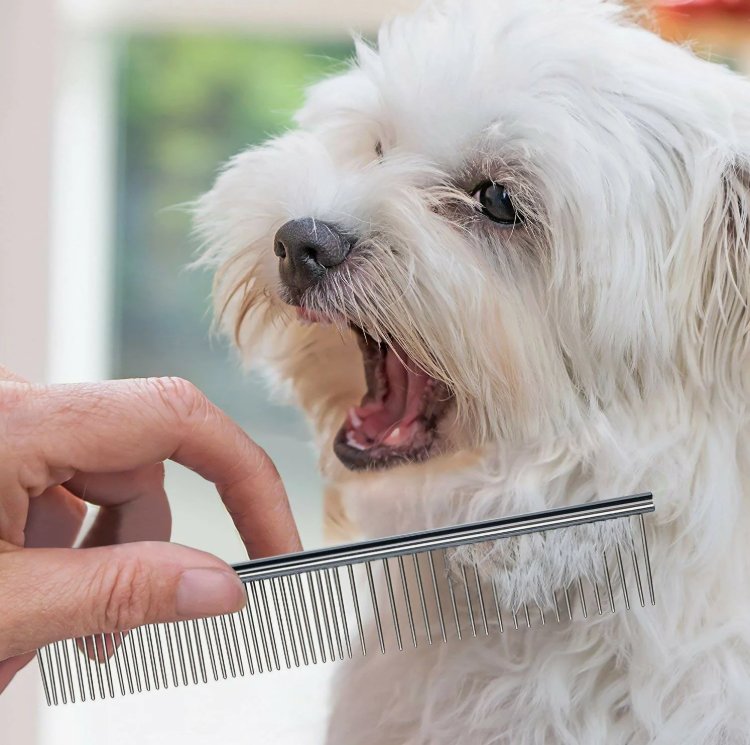
Long hair tends to form mats behind the ears and on the neck, in the armpits, on the belly, on the front legs, near the tail, and along the sides of the hind legs. This is especially common in small breeds that wear clothes during winter.
If your dog has a thick undercoat, you should lift the long hair gently, hold it with one hand, and carefully brush the undercoat underneath.
Grooming Method for Long-Haired Dogs
Grooming a long-haired dog should be done in three stages. First, use a comb with long and widely spaced teeth. Run it through the coat to align the guard hairs in the correct direction.
Next, use a brush or slicker brush. Lift the strands and gently brush out the undercoat, moving gradually from one section to another.
The third stage involves using a comb with fine teeth. Comb through the guard hairs on the dog’s back, neck, and chest.
How to Brush a Dog Without Causing Pain
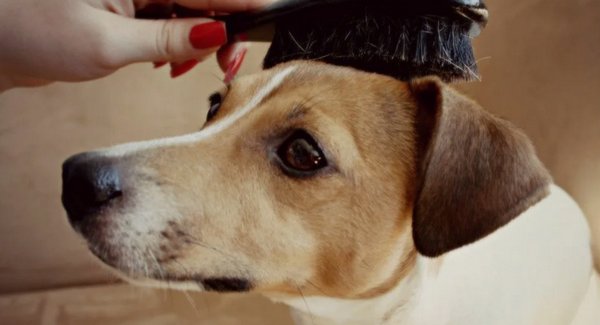
Long hair tangles easily. Even if there are no mats, brushing can still be unpleasant for the dog, because the comb or brush teeth catch on tiny knots, pulling the skin.
To prevent this, always start brushing a strand from the tips of the hair, holding it near the dog’s body with your other hand. Gradually work your way closer to the skin, making sure it doesn’t get pulled.
The belly and underarm areas are especially sensitive, while the withers and back are the least sensitive.
Let your movements be gentle and careful so the dog doesn’t feel discomfort. Remember, grooming should be a pleasant experience for your pet.
How to Deal with Mats
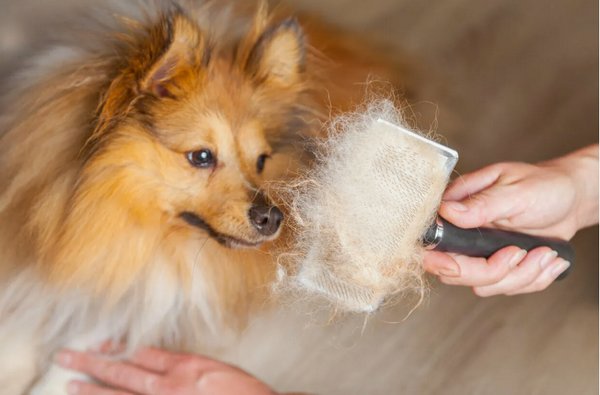
Mats are usually formed from dead hairs that get tangled in the coat. They twist the surrounding hairs—especially the undercoat—into a tight clump. If not removed in time, the mat can grow so large that it forms a thick, armor-like layer of matted hair. In that case, the only way to remove it may be to shave the dog completely.
Long-haired pets absolutely need a special anti-mat shampoo. It’s even better if the owner also has a quality conditioner, spray, or oil to help prevent matting.
The best way to deal with mats is to separate them with your fingers. Dampen the mat with a special spray, then gently work it apart. You can also cut the mat lengthwise with scissors along the direction of hair growth, dividing it into smaller sections for easier removal.
Small mats can be handled with a brush. Large ones are best trimmed out with special grooming scissors. You can use dematting tools as well, but if you’re not familiar with them, it’s better not to. The blades on these tools are sharper than scissors, and inexperienced use can injure the dog’s skin.
Even a regular knitting needle can help untangle mats if you blunt the tip to make it less sharp.
How Often to Brush Your Dog
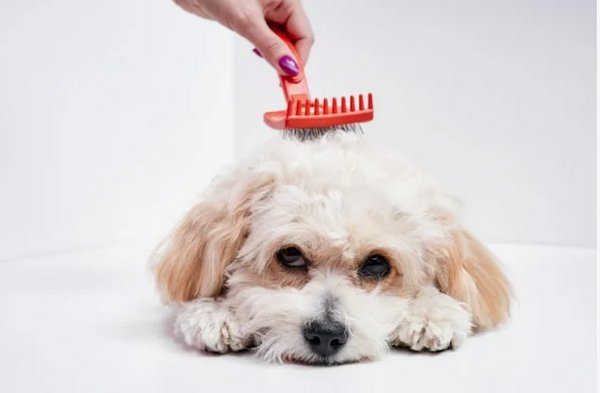
Short-haired dogs should be brushed once every 10 to 14 days, depending on the season. During shedding periods, you can remove loose hair daily using a grooming glove.
Long-haired dogs need to be brushed at least once a week, but ideally every two to three days. This helps prevent mats from forming altogether. However, if brushing frequently, avoid using a slicker brush every time, as it can thin the undercoat too much, leaving your dog cold during winter.
Even if you’re using a wide-toothed comb regularly, you should still brush the undercoat with a regular brush at least once every ten days to prevent it from tangling.
Beautiful, thick, and shiny fur is not only the result of grooming but also of proper nutrition. A balanced intake of vitamins, minerals, trace elements, and fats is the key to your pet’s health and beauty. Let your dog be happy and live a long life, bringing you joy with their presence!

